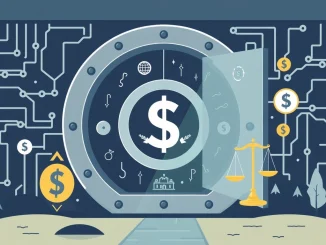
In a significant move highlighting the growing intersection of cryptocurrency and national security, the U.S. Department of Justice (DoJ) has announced a successful operation targeting terrorist financing. Law enforcement has seized approximately $200,000 in cryptocurrency from a digital wallet allegedly controlled by Hamas, a Palestinian militant group. This shocking revelation underscores the evolving tactics employed by illicit organizations and the proactive measures being taken to counter them within the digital asset space. But what does this mean for the future of cryptocurrency regulation and the fight against terrorism?
Unpacking the Crypto Seizure: How Did the DoJ Target Hamas?
The DoJ’s announcement detailed the seizure, explaining that the targeted cryptocurrency wallet was linked to Hamas and suspected of being used for money laundering activities. According to reports, this particular wallet is believed to have laundered around $1.5 million in funds for the organization. This operation is a testament to the increasing sophistication of law enforcement in tracking and intercepting illicit cryptocurrency transactions.
Here’s a breakdown of what we know so far:
- The Target: A cryptocurrency wallet associated with Hamas.
- The Amount Seized: $200,000 in cryptocurrency.
- Alleged Activity: Money laundering of approximately $1.5 million in Hamas funds.
- Agency Involved: U.S. Department of Justice (DoJ).
- Significance: Demonstrates the use of cryptocurrency for illicit financing and the DoJ’s capability to conduct crypto seizure operations.

Why is This Crypto Seizure a Big Deal?
This isn’t just about the dollar amount; it’s about the precedent it sets and the message it sends. The crypto seizure in this case is significant for several reasons:
- Combating Terrorism Financing: It directly addresses the critical issue of terrorism financing. By disrupting financial flows to groups like Hamas, authorities aim to weaken their operational capabilities.
- Cryptocurrency Regulation Implications: This incident will likely fuel further discussions and potentially stricter cryptocurrency regulation. Governments worldwide are grappling with how to oversee digital assets and prevent their misuse for illegal activities.
- Enhanced Tracking Capabilities: It showcases the growing ability of law enforcement agencies like the DoJ to trace and seize cryptocurrencies, dispelling the myth of complete anonymity in crypto transactions.
- Global Cooperation: Such operations often require international collaboration to track funds and identify individuals involved, highlighting the need for global cooperation in combating crypto-related crime.
Cryptocurrency Regulation: Is This a Turning Point?
The use of cryptocurrency by Hamas, as alleged in this case, shines a spotlight on the ongoing debate surrounding cryptocurrency regulation. While proponents emphasize decentralization and financial freedom, critics point to the potential for misuse in illicit activities. This seizure could be a catalyst for:
- Increased Scrutiny: Expect heightened scrutiny of cryptocurrency exchanges and wallets to ensure compliance with anti-money laundering (AML) and counter-terrorism financing (CTF) regulations.
- Stricter KYC/AML Procedures: Know Your Customer (KYC) and Anti-Money Laundering (AML) procedures might become more rigorous for crypto platforms to prevent the flow of funds to nefarious actors.
- Technological Advancements in Tracking: We may see further investment in blockchain analytics and forensic tools to improve the tracking and seizure of illicit cryptocurrencies.
- International Regulatory Harmonization: There could be a push for greater harmonization of cryptocurrency regulations across different jurisdictions to create a more unified global approach to oversight.
Hamas and Cryptocurrency: A Growing Trend?
The involvement of Hamas in cryptocurrency transactions isn’t entirely new, but this DoJ seizure suggests a potentially increasing reliance on digital assets for fundraising and operational finance. Why might groups like Hamas be turning to cryptocurrency?
| Reason | Explanation |
|---|---|
| Circumventing Traditional Financial Systems | Cryptocurrencies offer a way to bypass traditional banking systems, which are heavily regulated and monitored. This can be attractive for groups operating outside the mainstream financial sphere. |
| Perceived Anonymity | While not entirely anonymous, some cryptocurrencies and mixing services can offer a degree of obfuscation, making transactions harder to trace than traditional financial transfers. |
| Global Reach | Cryptocurrencies facilitate cross-border transactions relatively easily, enabling groups to receive funds from supporters worldwide. |
| Decentralization | The decentralized nature of cryptocurrencies means there’s no central authority to control or censor transactions, making them appealing for those seeking to operate outside government oversight. |
Money Laundering and Crypto: The Dark Side of Digital Assets
The allegation that the Hamas wallet was used for money laundering highlights a significant concern within the cryptocurrency space. Money laundering through crypto can involve various techniques, including:
- Mixing Services: Using services that obscure the origin and destination of cryptocurrency transactions, making it harder to trace funds.
- Privacy Coins: Utilizing cryptocurrencies with enhanced privacy features that make transactions more difficult to track.
- Decentralized Exchanges (DEXs): Trading on DEXs, which often have less stringent KYC/AML requirements compared to centralized exchanges.
- Layered Transactions: Complex chains of transactions across multiple wallets and exchanges to obfuscate the flow of funds.
The DoJ‘s success in this seizure demonstrates that despite these challenges, law enforcement is making strides in combating money laundering in the crypto sphere.
What Does the Future Hold for Crypto and Terrorism Financing?
This crypto seizure is likely just the beginning. As cryptocurrency adoption grows, so too will the efforts to regulate and monitor its use, especially in the context of terrorism financing. We can anticipate:
- More Proactive Enforcement: Increased proactive investigations and operations targeting illicit cryptocurrency activities, including terrorism financing.
- Technological Arms Race: A continuous cat-and-mouse game between law enforcement and illicit actors, with both sides developing more sophisticated tools and techniques.
- Greater Collaboration: Enhanced information sharing and cooperation between governments, law enforcement agencies, and the cryptocurrency industry to combat financial crime.
- Evolving Regulatory Landscape: Ongoing evolution of cryptocurrency regulations to adapt to the changing landscape and address emerging threats.
Conclusion: A Wake-Up Call for Crypto and National Security
The U.S. DoJ’s crypto seizure from a Hamas-linked wallet is a powerful signal. It demonstrates that cryptocurrency, while offering innovation and opportunity, is not immune to misuse. This groundbreaking operation serves as a wake-up call for the cryptocurrency industry, regulators, and national security agencies alike. It underscores the urgent need for robust cryptocurrency regulation, enhanced tracking technologies, and global collaboration to ensure that digital assets are not exploited for illicit purposes, particularly terrorism financing. The fight against crypto-facilitated crime is intensifying, and this seizure marks a significant victory in that ongoing battle.



